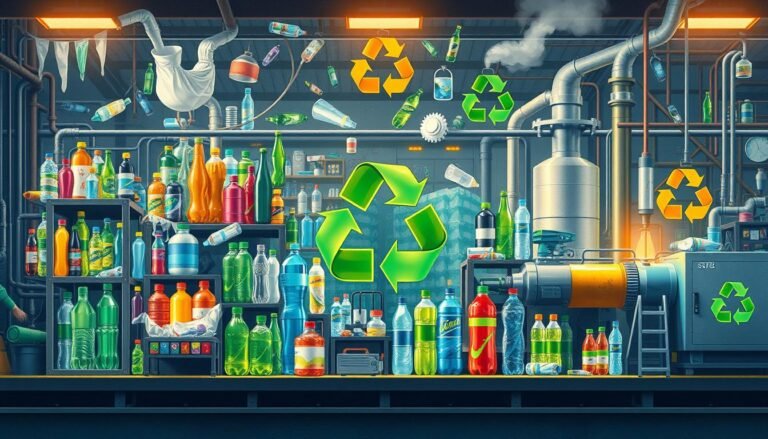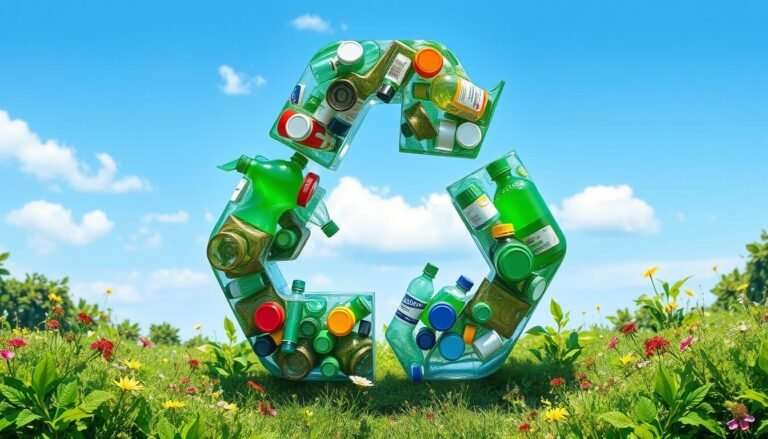Make some changes to the world environment
-
Building 3, Wanyang Innovation City, Langxia Street, Yuyao City, Zhejiang Province
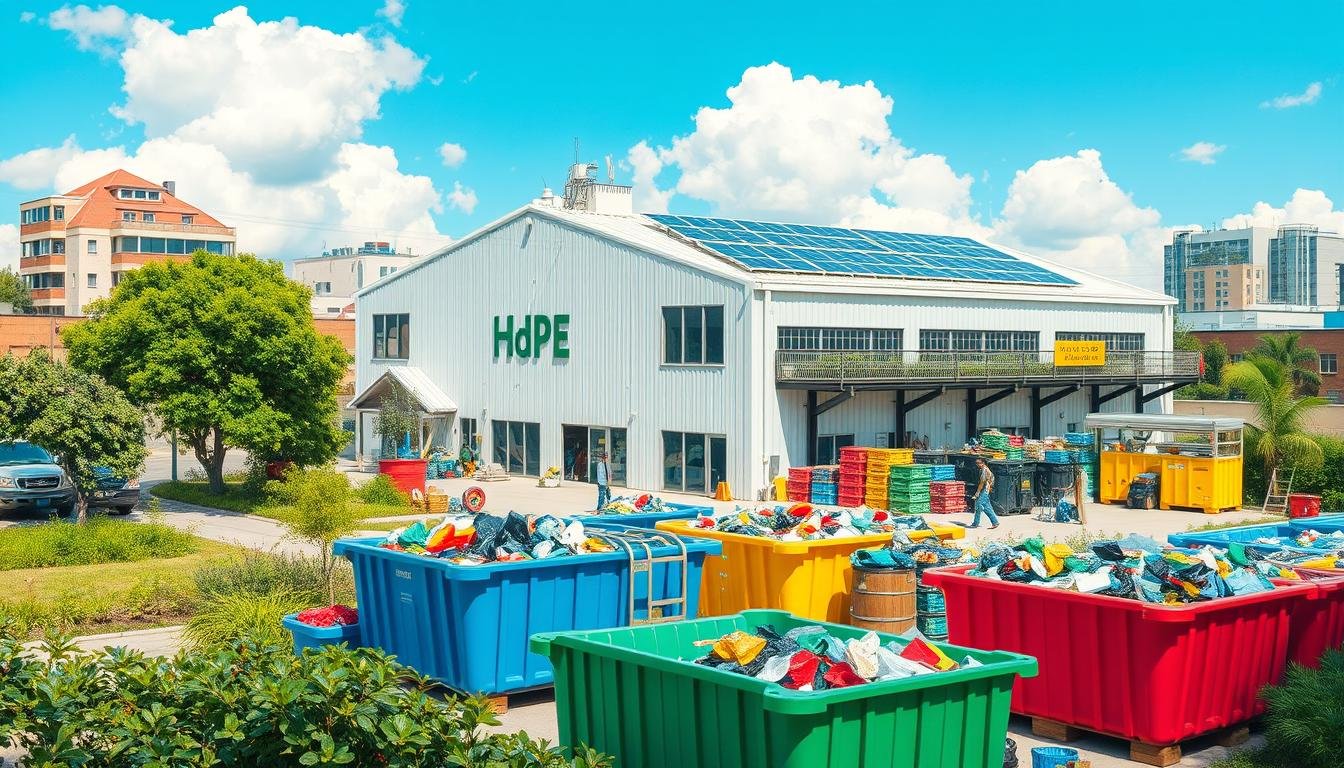
HDPE Plastic Recycling: Solutions for a Greener Future
In today’s world, we all care about the planet. We face big challenges from plastic waste. High-Density Polyethylene (HDPE) is a plastic that can be recycled, helping us move towards a greener future.
HDPE is strong and used in many things, like packaging and household items. But, it can harm the environment if not recycled. Recycling HDPE is a key way to lessen plastic waste and save resources.
By recycling HDPE, we can make our future more sustainable. We can use new technologies and work together to change how we handle HDPE. This way, HDPE can be used over and over, not just thrown away.
Key Takeaways:
- HDPE plastic recycling is crucial for promoting sustainability and reducing plastic waste
- Recycling HDPE conserves resources and supports a circular economy
- Proper management of HDPE waste is essential to mitigate environmental impacts
- Innovative technologies and collaborative efforts are key to effective HDPE recycling
- Embracing HDPE recycling paves the way for a greener future
Understanding HDPE Plastic: What It Is
High-density polyethylene (HDPE) is a strong and versatile plastic. It’s important today because of its durability and ability to be recycled. It’s used in many ways because of these qualities.
Properties of HDPE Plastic
HDPE is very strong and lasts a long time. It can handle chemicals well, making it great for many uses. It’s also light but strong, which is perfect for some products.
Here are some key things about HDPE plastic:
| Property | Value |
|---|---|
| Density | 0.93-0.97 g/cm³ |
| Melting Point | 130-137°C |
| Tensile Strength | 20-40 MPa |
| Elongation at Break | 100-1000% |
Common Uses of HDPE Products
HDPE is used in many places because it’s so versatile. It’s found in things we use every day and in big industrial projects:
- Packaging: Bottles, containers, and caps
- Construction: Pipes, fittings, and geomembranes
- Automotive: Fuel tanks and interior components
- Household: Toys, furniture, and appliances
Importance in Recycling Programs
HDPE is great because it can be recycled easily. Recycling HDPE helps make new things and saves resources. Recycling programs focus on HDPE because it’s in high demand.
“HDPE recycling not only helps to reduce the environmental impact of plastic waste but also creates new opportunities for businesses and consumers alike.”
Knowing about HDPE’s properties, uses, and recycling helps us see its value. It’s key to a more sustainable future.
The Recycling Process of HDPE
HDPE recycling turns old plastic into new raw materials. It’s a journey through the plastic recycling process at top recycling facilities.
Collection and Sorting of HDPE Waste
The first step is collecting and sorting plastic waste. Waste management teams and local recycling programs pick up HDPE items. These include milk jugs, detergent bottles, and plastic bags.
They then go to recycling centers for sorting. Sorting is key to keep only pure HDPE materials. Modern facilities use advanced tech like optical scanners and air systems to sort efficiently.
Cleaning and Shredding
After sorting, HDPE waste gets cleaned. This removes labels, adhesives, and leftover contents. Then, it’s shredded into small flakes by industrial machines.
Shredding makes the plastic easier to melt and reprocess. Some places also wash the flakes before the next step.
Extrusion and Remolding Techniques
The shredded HDPE flakes are melted and formed into long strands. These strands are cooled and cut into recycled pellets. The process makes the recycled HDPE consistent in quality and properties.
“Recycled HDPE pellets are a valuable commodity in the manufacturing industry, as they can be used to create a wide range of new products, from bottles and containers to automotive parts and construction materials.”
The recycled pellets are then remolded into new products. Techniques like injection molding, blow molding, or rotational molding are used. This makes HDPE versatile for many applications, closing the plastic lifecycle loop.
Benefits of HDPE Plastic Recycling
Recycling HDPE plastic has many benefits for our planet, businesses, and society. It helps us move towards a greener future. At the same time, it brings economic gains and saves resources.
Environmental Impact and Sustainability
Recycling HDPE plastic is good for the environment. It keeps waste out of landfills and turns it into new products. This reduces our carbon footprint.
It also needs less energy than making new plastic. This leads to lower emissions and a greener way to make things.
Economic Advantages for Businesses
Companies that use recycled HDPE save money. It’s often cheaper than new plastic. This cuts down on costs.
Using recycled HDPE also makes a company look good. It attracts customers who care about the environment.
“By using recycled HDPE in our packaging, we not only reduce our environmental impact but also save on material costs. It’s a win-win situation for our business and the planet.” – Sarah Johnson, Sustainability Manager at EcoPackaging Inc.
Energy Conservation Through Recycling
Recycling HDPE saves a lot of energy. It doesn’t need the energy needed to make new plastic. This cuts down on fossil fuel use.
HDPE recycling also helps keep resources in use. It reduces the need for making new plastic. This is good for our planet and helps us use resources better.
Challenges in HDPE Recycling
HDPE recycling has many benefits but also faces challenges. These include contamination, market changes, and tech limits in processing.
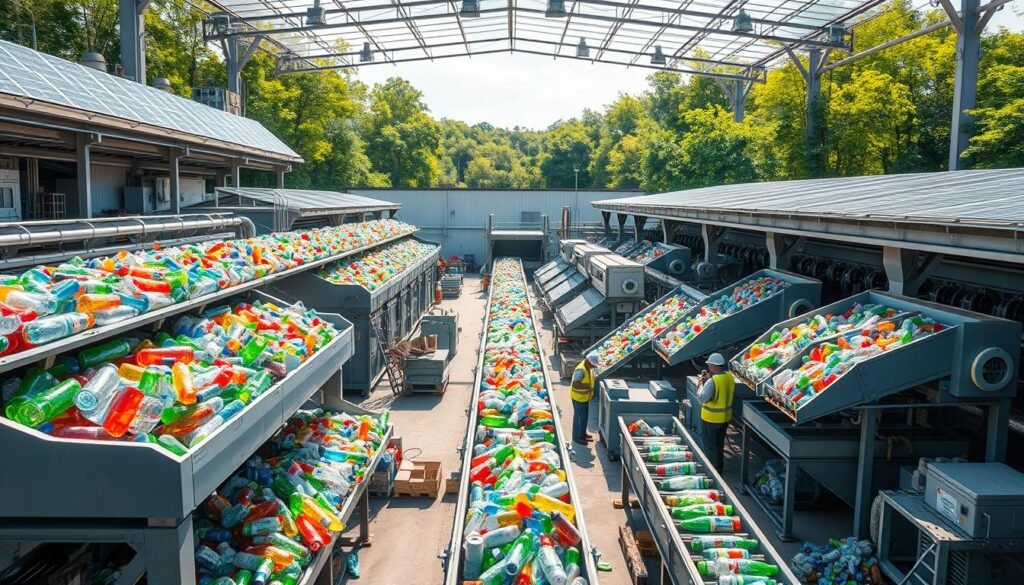
Contamination Issues and Solutions
Contamination is a big problem in HDPE recycling. Mixing non-HDPE or different HDPE grades can lower the quality of recycled products. To keep quality high, strict sorting and cleaning are needed.
- Advanced sorting technologies to separate HDPE from other plastics
- Thorough cleaning to remove contaminants such as labels, adhesives, and residues
- Implementing quality control measures throughout the recycling process
Market Fluctuations for Recycled HDPE
Price changes are another challenge for HDPE recycling. The demand and price for recycled HDPE can change due to many factors. These include:
| Factor | Impact on Price |
|---|---|
| Oil prices | When oil prices are low, virgin HDPE becomes cheaper, reducing demand for recycled HDPE |
| Market demand | Fluctuations in demand from end-use industries can affect the price of recycled HDPE |
| Quality of recycled HDPE | Higher quality recycled HDPE commands better prices in the market |
To deal with these price changes, recycling companies need to focus on making high-quality recycled HDPE. They also need to build strong relationships with end-use industries.
Technological Limitations in Processing
The HDPE recycling process also faces tech challenges. These include processing efficiency and handling different HDPE products. Innovation is key to solving these problems and improving recycling infrastructure. This includes:
- Developing advanced extrusion and remolding techniques
- Investing in research and development to create more efficient recycling technologies
- Collaborating with industry partners to share knowledge and best practices
“Overcoming the challenges in HDPE recycling requires a collaborative effort from all stakeholders, including recycling companies, end-use industries, and policymakers.”
By tackling contamination, market changes, and tech advancements, the HDPE recycling industry can grow. It can also help make our future more sustainable.
Innovations in HDPE Recycling Techniques
The recycling industry is seeing big changes to handle HDPE plastic waste better. These new methods improve the quality of recycled HDPE. They also help make our planet greener by cutting down plastic waste’s harm.
Advanced Sorting Technologies
Sorting HDPE plastics has gotten a lot better thanks to new tech. Automation and AI power these systems. They can tell HDPE plastics apart based on their makeup, color, and more.
This means recycled HDPE is purer. It can be used in more ways, which is good for the environment.
Chemical Recycling Processes
Chemical recycling, like pyrolysis and enzymatic recycling, is changing HDPE recycling. These methods turn HDPE into its basic parts. This lets us make new plastics that are as good as the original.
Chemical recycling opens up new uses for recycled HDPE. It also saves natural resources and cuts down on harmful emissions.
| Chemical Recycling Process | Description |
|---|---|
| Pyrolysis | Thermal decomposition of HDPE in the absence of oxygen |
| Enzymatic Recycling | Using enzymes to break down HDPE into its monomers |
Biodegradable Alternatives
New bio-based plastics are also being developed. They come from things like corn starch or sugarcane. These plastics are like HDPE but can break down naturally.
Using bio-based plastics can lessen the harm of plastic waste. It helps us move towards a more circular economy.
“The future of HDPE recycling lies in the seamless integration of advanced technologies, sustainable practices, and eco-friendly alternatives.”
The Role of Consumers in HDPE Recycling
Consumers are key to solving the plastic waste problem. By using eco-friendly habits and backing local recycling, we can help the planet. Recycling education helps us understand the importance of recycling.
Promoting Eco-Friendly Practices
Every day, we can make a big difference. Simple steps include:
- Choosing products made from recycled HDPE
- Properly sorting and disposing of HDPE waste
- Reducing single-use plastics
- Using reusable items instead
These actions help reduce waste and support recycling. They also encourage more recycling in the industry.
Understanding Recycling Symbols
Recycling symbols help us know how to recycle HDPE. Here’s a table of common symbols:
| Symbol | Description |
|---|---|
| ♳ | HDPE (High-Density Polyethylene) |
| HDPE | Shows the product is HDPE |
| 2 | Plastic resin code for HDPE |
Knowing these symbols helps us recycle right. It makes recycling easier and keeps it clean.
Supporting Local Recycling Initiatives
Getting involved in recycling is crucial. Ways to help include:
- Joining curbside recycling programs
- Going to recycling events
- Pushing for better recycling facilities
- Telling others why recycling HDPE is important
Every person can help fight plastic waste. By living eco-friendly and supporting recycling, we can make a better future.
As we learn more about our impact, we can change the recycling world. Together, we can make our world greener and more sustainable.
Policy and Regulation Impacting HDPE Recycling
Government policies and regulations are key to boosting HDPE recycling. They help set waste reduction goals. Good laws and global standards are vital for a greener recycling industry.
National Recycling Policies
Many countries have recycling policies for HDPE. These include waste reduction targets and recycling incentives. Here are some examples:
- The United States’ Resource Conservation and Recovery Act (RCRA)
- The European Union’s Waste Framework Directive
- Japan’s Containers and Packaging Recycling Law
State-Level Initiatives
States also play a big role in HDPE recycling. They have their own recycling programs and offer grants. For instance:
| State | Initiative | Goal |
|---|---|---|
| California | Bottle Bill | 80% recycling rate for beverage containers |
| Michigan | Clean Michigan Initiative | $675 million for environmental protection and recycling |
| New York | Returnable Container Act | 5-cent deposit on beverage containers to encourage recycling |
Global Standards for HDPE Waste Management
Global guidelines are crucial for managing HDPE waste worldwide. Groups like the United Nations Environment Programme (UNEP) and the Basel Convention set standards. They push governments to adopt recycling-friendly policies.
“Plastic waste is a global problem that requires a global solution. We must work together to develop and implement effective policies and regulations that promote recycling and reduce waste.” – Dr. Jane Goodall, environmental activist
Strong policies at all levels are essential for a sustainable HDPE recycling future. Government support, laws, and global standards are vital for meeting waste reduction goals. They help create a circular economy for plastics.
Collaborations Among Stakeholders
The success of HDPE plastic recycling depends on teamwork. Industry partners, non-profits, and local communities must work together. This teamwork drives positive change and aims for a sustainable future.
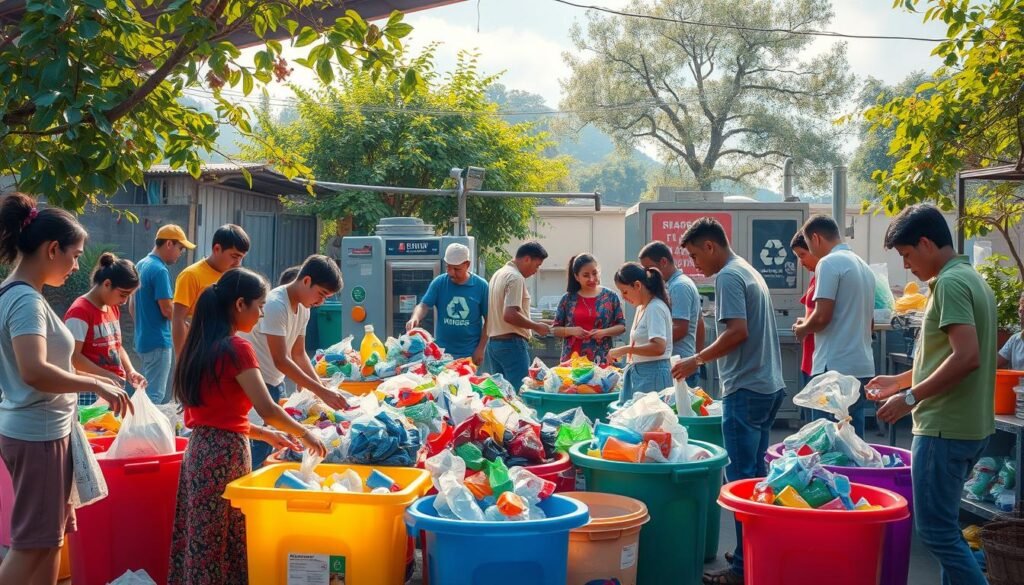
Working together is key to improving HDPE recycling. Industry leaders share knowledge and resources. This leads to innovation and better recycling processes. These efforts benefit the environment and create jobs.
Industry Partnerships for Recycling
Industry partnerships are vital for HDPE recycling. Companies can improve collection and sorting. They also find new uses for recycled materials. These partnerships involve:
- Sharing research and development efforts
- Setting industry standards and guidelines
- Starting joint recycling programs
- Investing in new recycling technologies
Non-Profits Advocating for Change
Non-profits lead the fight for better HDPE recycling. They raise awareness, influence policies, and support local efforts. Their work includes:
| Organization | Focus Area | Impact |
|---|---|---|
| Plastic Pollution Coalition | Reducing plastic waste | Educates and empowers individuals |
| Oceana | Protecting marine life | Campaigns for policy changes |
| Sustainable Packaging Coalition | Promoting sustainable packaging | Develops industry guidelines |
Community Engagement in Recycling Efforts
Getting local communities involved is crucial. It builds a sense of responsibility. This leads to grassroots movements and positive change. Ways to engage communities include:
- Hosting educational workshops and events
- Starting neighborhood recycling challenges
- Working with schools and youth groups
- Supporting local recycling efforts
“Alone we can do so little; together we can do so much.” – Helen Keller
Together, industry partners, non-profits, and communities can make a big difference. Through teamwork, we can achieve a sustainable future for all.
Case Studies: Successful HDPE Recycling Programs
Around the world, new ideas are showing us best practices in HDPE recycling. From local programs to big companies and startups, these stories show the impact of sustainability leadership. Let’s look at some great examples of HDPE recycling success.
Municipal Programs Leading the Way
Local governments are leading the change in HDPE recycling. In San Francisco, the “SF Recycles” program has hit an 80% landfill diversion rate. HDPE plastics are a big part of this success.
The city’s curbside collection and education have been key. In British Columbia, Canada, “RecycleBC” is a top example of extended producer responsibility. It has a 75% recovery rate for HDPE packaging, setting a high standard for recycling.
Corporate Initiatives in HDPE Recycling
Big companies are also tackling HDPE recycling. Procter & Gamble aims to use 100% recyclable or reusable packaging by 2030. They’re using new sorting tech and working with recycling partners to boost HDPE recovery.
The Coca-Cola Company’s “World Without Waste” campaign is another big effort. It aims to collect and recycle every bottle or can sold worldwide. By improving recycling infrastructure and educating consumers, Coca-Cola is leading in sustainability.
Innovative Startups Making a Difference
Entrepreneurship is bringing new ideas to HDPE recycling. Companies like Renewlogy and Biocellection are creating advanced recycling processes. These turn HDPE waste into valuable products, helping the environment and creating jobs.
Replenysh is also changing HDPE recycling with its digital platform. It connects businesses with extra materials to recyclers and makers. This startup is helping create a circular economy for HDPE plastics, showing the power of new ideas in sustainability.
The Future of HDPE Plastic Recycling
HDPE plastic recycling is key to a sustainable future. New technologies and solutions are changing HDPE recycling. This shift will make our world greener.
Trends in Recycling Technologies
New technologies are transforming HDPE recycling. They include advanced sorting and recycling facilities. These innovations make recycling more efficient and effective.
By using these technologies, we can recycle more HDPE. This brings us closer to a zero waste future.
Circular Economy and its Implications
The circular economy is becoming more popular. It focuses on using resources over and over. For HDPE, this means designing products for recycling.
Businesses adopting this model can reduce waste. They also find new ways to grow and innovate.
“The transition to a circular economy is not only an environmental necessity but also an economic opportunity. It represents a systemic shift that builds long-term resilience, generates business and economic opportunities, and provides environmental and societal benefits.” – Ellen MacArthur Foundation
Predictions for HDPE Usage and Recycling
Market trends show more demand for recycled HDPE. Consumers and governments are pushing for less plastic waste. This growth is good for the recycling industry.
By investing in sustainability, companies can lead the way. They help create a greener future.
The future of HDPE recycling is promising. With new tech, sustainable models, and a circular economy, we can manage plastic waste better. Let’s work together for a cleaner planet.
How We Can Improve HDPE Recycling Efforts
To make HDPE recycling better, we need a few key steps. We must teach people about recycling, get them involved, and make sure trade is fair. These actions will help us make a greener future for recycling HDPE.
Education and Awareness Campaigns
Public outreach is key to better HDPE recycling. Teaching people how to recycle HDPE right can help a lot. We can spread the word through:
- School programs for kids about recycling
- Community workshops on green living
- Social media campaigns for HDPE recycling
Encouraging Participation in Recycling Initiatives
We need to give incentives for more people and businesses to recycle HDPE. Here are some ways to do that:
- Deposit-return schemes for HDPE containers
- Tax breaks or grants for using recycled HDPE
- Easy places to drop off HDPE waste
By making recycling easier and rewarding, we can get more people involved. This will help more HDPE get recycled.
Fair Trade Practices in Recycled Materials
For HDPE recycling to last, we must focus on ethical sourcing and supply chain transparency. This means:
| Practice | Benefit |
|---|---|
| Working with suppliers who treat workers fairly | Ensures workers are treated ethically |
| Using systems to track recycled HDPE | Increases transparency and accountability |
| Supporting sustainable sourcing efforts | Encourages responsible practices in the supply chain |
“By prioritizing fair trade practices, we can create a more equitable and sustainable future for HDPE recycling.” – Jane Smith, Sustainability Expert
Through education, getting people involved, and fair practices, we can greatly improve HDPE recycling. Working together, we can make our future cleaner and greener. To learn more about sustainable plastic production, visit Understanding What Plastic Is Made Of.
Conclusion: A Collective Responsibility for a Greener Future
We’ve looked at how important HDPE plastic recycling is for a sustainable future. Understanding HDPE’s properties and uses shows its value in our lives. Recycling HDPE helps the environment and saves energy, making it crucial for us all.
Summarizing Key Takeaways
HDPE recycling faces challenges like contamination and market changes. But, new recycling methods and teamwork offer hope. Innovations and partnerships are making progress, showing we can change for the better.
Encouraging Action for Change
We all play a big part in recycling. By choosing eco-friendly options and supporting recycling, we help a lot. Small actions can lead to big changes, making a difference for our planet.
Our Role in the Recycling Revolution
Our actions today shape the future of HDPE recycling. By using new recycling tech and supporting fair trade, we can make a difference. It’s up to us to act and support efforts for a greener tomorrow.


